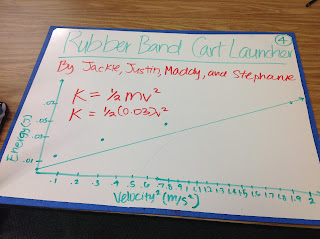Law#2: Force equals mass times acceleration, F=ma. Mass and acceleration are indirectly proportional.
Law#3: When two objects interact they exert equal but opposite forces on one another. They feel a force that is...
- The same type(typically normal, friction, or gravitational)
- The same amount(no matter how big or small, the force felt is the same)
- Opposite
Hover Disk Lab
Big Question-What gives rise to a change in motion?
The purpose of this lab was to learn which forces are pulling on certain objects, in this case two people, the ground and a hover disk, by knowing Newtons 1st and 3rd laws. We experimented with a hover disk and learned that it blows air out from the bottom to eliminate friction, allowing it to glide on smooth surfaces. Theoretically if you pushed the disk, and if the surface was infinitely smooth(and if there is no air resistance), it would glide in a straight line forever. For a while we played around with the disk and passed it along to one another, simulating the diagrams in our worksheet. We used interaction diagrams and free body diagrams to chart the forces acting on each individual object.
In this diagram the disk is on but at rest and has not been pushed yet. The earth has a normal and gravitational force with each object, yet none of the objects are interacting with each other at this time. Its strange to think that the earth and person 1 are feeling the same force from each other but it is true!
We also drew a free body diagram as a second way to show the force between each object
involved.The arrows are vectors that represent the forces acting on the disk.
This is another diagram we drew, but this time the hover disk is on and being caught by person 2. This is different from the first diagram because the disk and person 2 are now interacting. They have a normal force acting upon them.
Fan Cart Lab
Big Question- What is the relationship between force, mass, and acceleration?
From this lab we learned that F=ma. This means that if the mass increases then the acceleration decreases(and vice versa), to equal the force. In other words, the net force on an object is equal to the mass of the object multiplied by its acceleration. This is proven by the data we collected. Although trial 4 does not fit the pattern, we concluded that this was due to human error.
As you can see trial 4 is the outlier, so we calculated the percent error to find out our mistakes.
Real World Connection
I found this video about Newton's Laws of Motion applied to everyday life. I liked how it had multiple examples to show just how common these theories are in the real world, not just in the classroom. In the video it showed a game of pool. The ball would remain still and at rest unless an outside force pushes it. Once hit, the balls move in the direction that they are expected to depending on the angles that they are hit at. It was interesting for me to see that something as simple as pool can relate to physics.
http://videos.howstuffworks.com/discovery/29421-assignment-discovery-newtons-laws-of-motion-video.htm





























